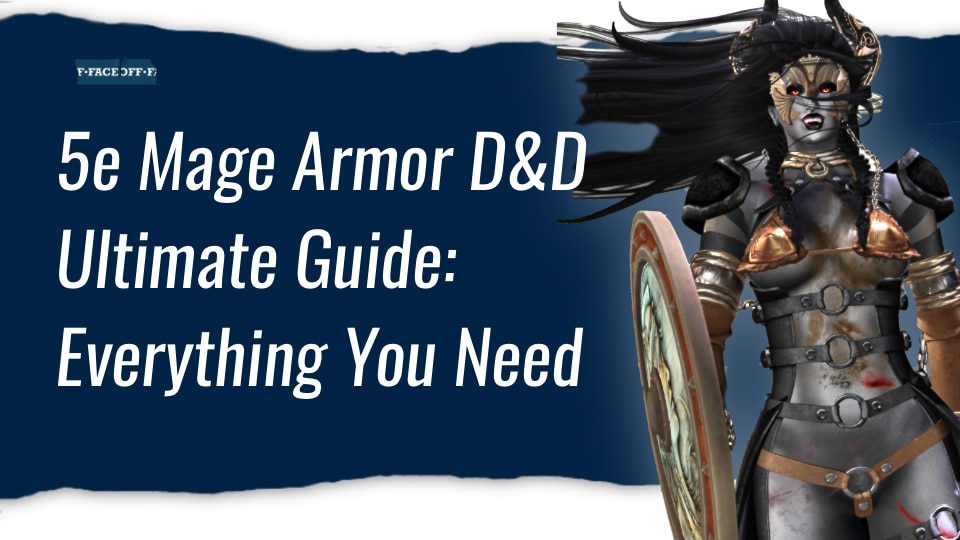One of the most popular spells in D&DS is the Mage armor. It has many advantages, it’s free, and it lasts. Casting Mage Armor in the 5th edition of Dungeons and Dragons may seem simple and easy, but casters must be proficient in the use of shields. Using 5e Mage Armor without proficiency has heavy drawbacks, and every serious player must know how to use them. So, here is a complete guide on Mage Armor 5e, giving you answers and important tips to maximize your D&D spell skills.
In this Faceoff, we will go over everything that fantasy players need to know about Mage armor in 5th edition Dungeons & Dragons, including important feats like shortcuts, duration, when to use it, and how.
What is Mage Armor in 5th edition D&D?
Sorcerers and most forms of wizards and warlocks’ main armor tools are mage armor and shield, it’s a protective spell that boosts a wizard for hours and as a reaction, respectively.
For the latest version 5e, in the form of Mage armor will give an effective AC increase in base armor by 13 bonus, excluding your DEX bonus. In general, the Mage Armor and Shield spells are the only armor you will have 90% of the time.
How does 5e Mage Armor work?

Your creatures need to be unarmored for this spell to work. If this requirement is met, touch the creature, and the armor will come into action for as long as you don’t wear any other armor.
There are some pretty big dungeons and forests in the game, which takes some time, and this armor lasts for eight hours, so it is a perfect match for all such adventures. Only spell casters can dismiss it. Unlike other similar spells, it’s easier to cast from anywhere on the battlefield.
The simple answer is no because this armor provides AC, and you should choose an armor with the highest AC for better results.
What 5e Mage armor looks like? Is it visible?
Both players, as well as DM, can decide the appearance of the armor in D&D 5e. It takes some time to choose the appearance, players can get advice from DM when they choose it manually. It is basically a combination of arcane runes, and it glows.
There are lines on the caster. A bright flash appears from the character when the spell hits them, and this makes the armor visible for a short time. The question of whether you can see the mage armor or not depends on the situation because it is nothing more than a bright glow.
What is the best Mage Armor in 5th Edition D&D?
Mage hand is a good spell, and you don’t need any components to cast it. It is the best match for those who want to tackle obstacles in a creative manner. It can steal items for you as well as bring potions some feet away. It doesn’t cast any damage at all because it is an intelligence-based spell. The player with mage hand armor can turn the battle in your way.
Mage Armor 5th Edition: What are their advantages and weakness?
Below is the complete list of all the mage armor 5th edition.
BRACERS OF DEFENSE 5E: this armor can increase the overall AC of a character by two, but you have to unequip all the existing armor first. You cant equip it if you are carrying a shield. It works with a large number of warlock characters in the game.
MITHRAL ARMOR 5E: You can hide this armor under plain clothes, and it is a magical material. Beginners can also wear it as there is no strength requirement. Your allies can see the mithril armor if you get hit by enemies.
ARMOR OF RESISTANCE 5E: This armor can increase the resistance of a damage type.
MAGE ARMOR 5E: This armor works perfectly well with plain clothes and increases the AC of the target for eight hours.
If you are a low-level player, opt for other spells instead of the mage armor because it isn’t a good choice for you. This armor focuses on defense only, and you won’t be progressing much, especially at the start of the game with this armor.
Mage armor is the perfect match for high-level players as it is an extra layer of protection. You will be able to get the job done with it even if you make some mistakes.
Advantages
The biggest advantage of armor d&d 5e for wizards, sorcerers, and other similar classes is that it increases their chances of surviving a battle to a large extent. The field advantage of the mage armor is also great.
Disadvantages
There are some side effects of the mage armor, and players don’t like to wear it for eight hours straight when they cast it. This makes the mage armor their second choice because they need encounter time. At the start of the game, low-level players have limited slots, and the mage armor lasts for eight hours, so they can’t use the slot for the time being. This can impact their performance negatively.
Mage Armor vs. Shield: Which is better?
The question of which armor 5e is a better all-around item has been unanswered for a long time now. If you have the option of choosing a Mage armor or a shield, pro players recommend mage armor in most cases. The shield is quite unsafe compared to the mage armor.
Mage armor defends against various spells, and the appearance is much better in this case. Shield helps you quickly leave an area or get out of a difficult situation. The AC of the shield is eighteen, while the AC of mage armor is around sixteen. Surprise attack enemies with the shield and trigger wild magic spells to defeat them in the battle.
Why are 5e Mage Armor and Shield so popular as l1 spells?
Both shield and mage armor don’t conflict in any way because they work differently. You can use a shield even if it’s not your turn, while mage armor requires an action. Pro players advise that you should use a shield during the battle while casting the mage armor before the battle.
A spell with 18 AC and a dexterity bonus is pretty difficult in the game. If there is no dexterity bonus and AC is 17, this isn’t good as well. You should avoid exceeding Plate 18 of your high dexterity character to keep all the armor d&d 5e validated. If a beginner or intermediate level dexterity character has 17AC, this makes the situation worse.
Can you cast Mage Armor 5e on Familiars as well as creatures with natural armor?

Yes, you can cast the mage armor 5e spell on familiars as well as creatures with natural armor, but there is a limit to how many AC calculations you can apply at a time. Apply the mage armor on a creature whose natural AC isn’t high, and you will see what wonders can mage armor do.
Can you cast Mage Armor on multiple allies in 5th Edition D&D?
One of the most common complexities of understanding the armor’s ability to be cast on multiple allies. You can cast Mage Armor on more than one person. It is non-concentration and therefore comes with a range of features. It allows the spellcaster to cast Mage Armor on multiple allies and creatures simultaneously. However, you will need 1 level 1 spell slot each time you make the cast on another ally.
Who is eligible to wear Mage Armor? Can you use it on yourself?

Commonly, only two classes can cast Mage Armor; however, others can also cast it in other ways!
Sorcerer and Wizards are two classes that can use Mage Armor. Aside from them, Clockwork Soul Sorcerer, Arcane Trickster Rogue, and Eldritch Knight Warriors can also cast Mage Armor. When these subclasses level up, they get a chance to cast one of the sorcerer’s spells.
The Mage Armor is better than most available protective armors. Fighters wear padded and leather armor; both have 11+ dexterity modifiers. The better one is studded leather armor with a 12+ dexterity modifier. However, with the Mage Armor, the dexterity modifier increases to 13+.
You can cast the spell of Mage Armor on yourself as well. It will boost your base, armor class, and target.
Dragonborn ancestry can also use Mage Armor in 5e, it will boost the rating to a higher degree for Dragonborn with the shield.
What does or doesn’t Mage Armor stack within 5th edition D&D?
Mage 5e is a phenomenal addition, boosting the energy levels of the gamers. It can stack with anything that ensures an AC bonus and boost. However, Mage Armor cannot stack with the things that provide a set of AC.
Mage Armor is typically a protective layer or a magical ring, safeguarding from magical and physical barriers. It has perks that promise a balance between the game itself, the enemies, and the player. Mage Armor keeps the game fair and square!
The Mage Armor stacks with different things, such as bladesong. It provides a bonus to AC. Robe of protection and shield spell can also stack with Mage Armor.
However, Wildshaped druids, leather armor, light armor, normal armor, and unarmed defense cannot stack with Mage Armor. They provide a set of AC!
How Good is 5e Mage Armor, is it worth it?

5e Armor is a beloved spell in D&D, especially for those who have been playing for a long time. It provides their Sorcerers with an additional layer of protection. It stabilizes their sorcerer’s force and enhances the course of action. However, if you play strategically, Mage 5e can be used later!
For a Sorcerer, Mage Armor isn’t a perfect shot! Being said that, when you are moving forward with the game, you must have a plan in your mind. Cleaning up all the defenses and neglecting the power of offense is one of the biggest mistakes in Dungeons and Dragons.
So, instead of continuously tweaking the defense, focus on your offensive side. Leave the Mage Armor for later use until it reaches its full extent of defense and offense.
Mage Armor in the 5th edition of D&D is an excellent idea if you are not well-versed in armors. If your spell slot is available to be used on it. And you become an easy target for your enemies.
Are there Mage Armor 5e shortcuts that make them available all the time?

Yes, there is! If your sorcerer carries a staff of defense, then they can cast Mage Armor up to ten times a day. But there is a trick here!
When you cast Mage Armor, your player will have the additional layer of protection for eight hours. It would be best to cast Mage Armor again before the eight-hour time period expires. The reason is that if you failed to cast earlier, then you have to wait eight hours to cast it again.
But do you know about Eldritch Invocation? It is the forbidden knowledge in D&D, accessible to the warlocks. Eldritch Invocation allows warlocks to cast Mage Armor on themselves continuously.
Technically, Eldritch Invocation is called “Armor of Shadows” in the game. So, when the player casts Mage Armor through this process, they don’t need to use any spell slot or the material components required for the spell.
Eldritch Invocation is great for warlocks as they are proficient in light armor only!
What bonus action would you get for Mage Armor in 5th edition D&D?

Mage Armor D&D. 5e comes with bonus action to allure and attract gamers. So, what bonus action can you expect to receive with Mage 5e?
Since Mage Armor is an invisible field of force that ensures an exceptional extra layer of protection, the bonus action it offers is a 4+ AC. It makes a complete 13+ dexterity modifier. If your character has a +3, then with Mage Armor, the total AC will become 16+.
Mage Armor is a unique armor that doesn’t affect other things in Dragons and Dangenos 5th edition. For instance, speed drop, spell failures, exchange with other spells, and armor check penalty.
How can you improve the low-level 5e Mage Armor Class?

The core reason for having a Mage Armor is to keep higher AC for the spellcasters. It is competitive with the people who are wearing the armor.
However, there are not some quick ways to improve low-level Mage Armor Dnd 5e.
First and foremost, the Sorcerer is sacrificing their investments in CON and INT to pump dexterity modifier. Then it would help if you had attunement for it to work. When you reach level 7, you’ll compete with other wands, staves, and more powerful items.
With Martials, your defense can have a +1 or +2 or +3. This magic armor will help in closing the gap. Enemy spellcasters or players with an anti-magic field can also dispel it. It will not be saving you from WIS or CON saving throws. However, you can throw many low-attack-bonuses to enjoy better and higher AC. It would be best if you dropped a cone of cold on them occasionally.







